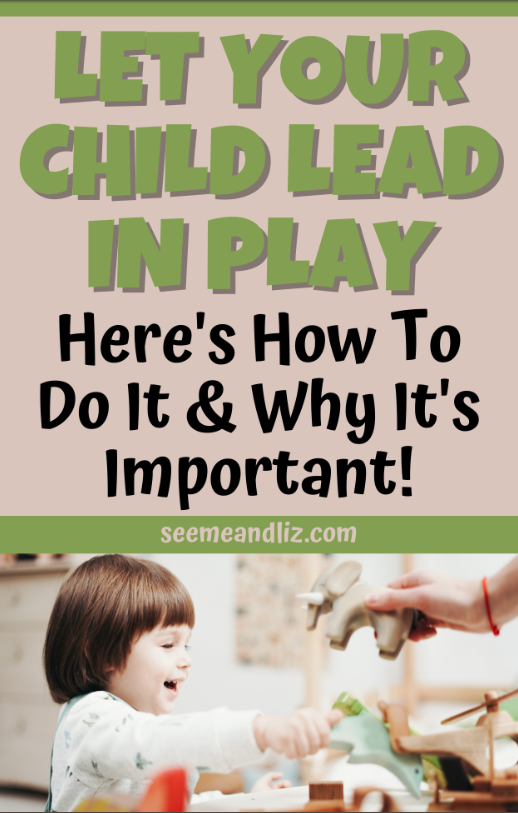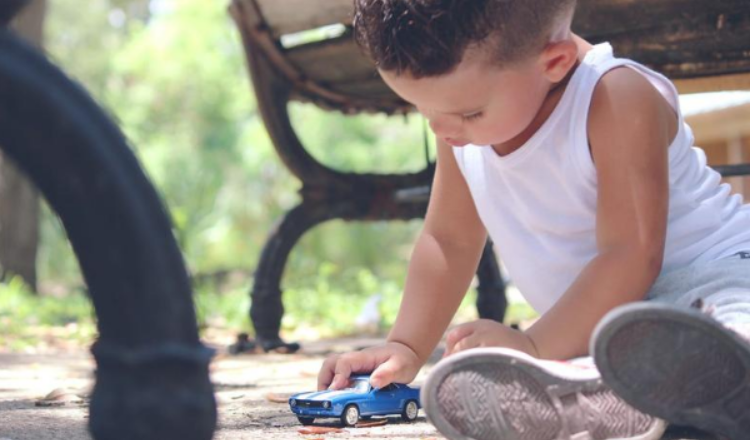Children of all ages have their own agendas (as do many adults).
We all learn best when we are interested in something.
The same goes for babies, toddlers and children.
Because this is so important I want to show you why and how to follow your child’s lead in play!
The Benefits of Child Led Play
The Hanen Centre
There is an organization out of Canada called The Hanen Centre that is a wealth of information regarding how to follow your child’s lead and why it is so important, especially during the toddler years.
Speech-Language Pathologists can become Hanen certified trainers for a variety of different programs.
I became certified in “It Takes Two to Talk” when I was practicing as a Speech–Language Pathologist.
This course taught me so much about children and play as well as the importance of following your child’s lead during play.
A lot of the information that I am going to share with you is based on Hanen’s research.
For more information regarding The Hanen Centre, please click here.
Observe, Wait and Listen
These 3 simple words will go a long way when it comes to your child’s play skills and language development.
As I mentioned at the start of this article, we are all going to learn if we are interested in something.
All children, regardless of age, will be interested in something.
A baby may be interested in the sound a rattle makes, or how it feels when they bite on it.
A toddler may be engrossed in building a block tower and knocking it down.
An older child may enjoy learning the rules of a new board game.
So, when you see your child gravitate to a particular toy or object, observe what they are doing.
Then pause some more and listen.
Are they vocalizing or saying any words?
Before you jump in with your agenda, give your child some space. See what they are interested in.
Let’s look at blocks as an example.
An adult’s agenda would probably be to build something that resembles an object, such as a house or a tower and then look at it with admiration and accomplishment.
However, this may not be the agenda your child has in mind.
If your child is young, they may want to smash the blocks together to hear what sound they make.
Or maybe they want to throw them into a bucket and then dump them out.
Depending on your child’s age, this can be very normal behavior. This is your child figuring out cause and effect relationships.
But we as adults want to teach our children how to use these items properly.
Don’t worry, there is time for that and they will learn this.
How To Follow Your Child’s Lead
At this point you probably have a pretty good idea as to what following your child’s lead is all about.
To re–iterate, following your child’s lead means that you are showing genuine interest in what your child is interested in.
You will show your interest by how you communicate with your child. At this point you can also build on what they are telling you.
There are several different ways that you can follow your child’s lead, some of these are:
♦ Join In And Play
It’s really that easy! Get down on the floor and start interacting.
If your child is playing with a car, grab another car and drive it alongside theirs.
Depending on the age of your child, you can make fun sounds (e.g. weee, vroom, beep beep, eek, etc) or help build their vocabulary by adding some words such as “up”, “down”, “fast”, “slow”, “stop”.
Think back to when you were a child and try acting like a child yourself.
Despite how simple this seems on the surface it can be quite difficult for parents, but kids love this – seeing their parents acting like children.
They will become more engaged, so let it out and be silly!
Who knows, it might be a much needed source of stress relief for you as well as your child!
♦ Respond With Interest
If your child is trying to interact with you, make sure to respond.
And show an interest in what they are trying to communicate.
Your baby may look up at you and coo, this is their way of “talking” to you.
Respond back by either imitating the sound or answer them using simple, but grammatically correct language.
By responding immediately and enthusiastically, you are telling your child that you are interested.
♦ Make Comments, Imitate and Interpret
I’m not going to get into ages here because children all learn to communicate at their own pace, so instead, I will discuss the “stages” children may be at with regards to language development.
If your child is making sounds and using gestures, imitate those sounds and gestures.
You can try and interpret what they are trying to communicate.
For example if your child is raising their arms up while saying “uh, uh, uh”, you would probably assume this means they want to be picked up.
Rather than running over and picking up your child, try responding with something like “Oh, you want up. I can pick you up” and then pick them up.
You can expand on this by making it fun. Lift your child up higher and say “up, up, up”.
This will probably make them laugh and you have just created a wonderful learning moment.
If your child is using some words, expand on those words.
For example, if they say “baby sleep” while playing with a doll, you can comment and say “yes, the baby is sleeping. She must be tired” and then let out an exaggerated yawn.
Again, rather than just sitting back or you taking over your child’s play, you are following their lead.
It is ok to add to the play, but try to do it as naturally as possible.
So after the “baby” has slept for a while, you could suggest that the “baby” is hungry and now its time to feed it.
However, if your child decides to give the “baby” a bath instead, then go with that.
With today’s reality of busy schedules, it’s often hard to sit back and watch your child play and then get down to their level and interact with them, sometimes acting like a child yourself.
For some parent’s this will take some time while for others it comes naturally. It is ok if this does not feel natural for you.
Try to do this for a few of your child’s interactions and soon you will be a pro.
For more information on the importance of following your child’s lead in play, check out Hanen’s “Parent Tips”.





